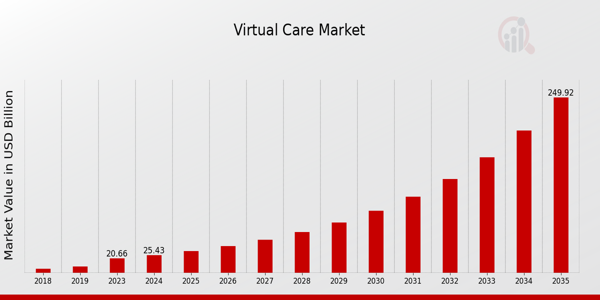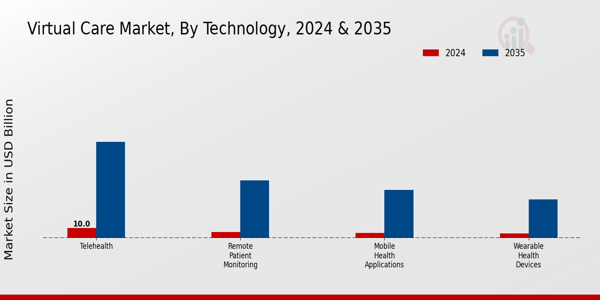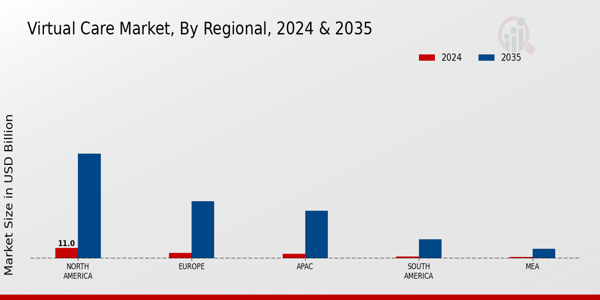Global Virtual Care Market Overview
As per MRFR analysis, the Virtual Care Market Size was estimated at 20.66 (USD Billion) in 2023.
The Virtual Care Market Industry is expected to grow from 25.43(USD Billion) in 2024 to 250.0 (USD Billion) by 2035. The Virtual Care Market CAGR (growth rate) is expected to be around 23.09% during the forecast period (2025 - 2035).
Key Virtual Care Market Trends Highlighted
The Global Virtual Care Market is significantly driven by increasing demand for accessible healthcare services. Factors such as the rising prevalence of chronic diseases, the need for cost-effective healthcare solutions, and the growing acceptance of telehealth services are fueling this market. Patients are increasingly looking for flexible options that allow them to receive care without the need for in-person visits. Additionally, advances in technology, including improved internet connectivity and mobile health applications, are making virtual care more convenient and effective. The shift towards patient-centered care is prompting healthcare providers to adopt virtual solutions to enhance patient engagement and satisfaction.Opportunities within the Global Virtual Care Market are vast, particularly as healthcare systems continually strive to improve efficiency and patient outcomes.
Organizations can explore the integration of artificial intelligence and machine learning to personalize care plans and predict patient needs. There is also a significant opportunity in expanding virtual mental health services, which have seen increased demand due to the pandemic. Furthermore, targeting underserved populations, including those in rural areas or with limited access to traditional healthcare, presents an opportunity for market players to broaden their reach and impact. Recent trends in the Global Virtual Care Market highlight an increasing emphasis on remote patient monitoring and digital therapeutics.More healthcare providers are investing in platforms that enable continuous monitoring of patients’ health from their homes. This trend coincides with a growing acceptance of digital solutions among both healthcare professionals and patients, driven by positive experiences during the pandemic. Furthermore, there is a notable increase in partnerships between technology companies and healthcare organizations to enhance virtual care offerings, indicating a collaborative approach to meeting the evolving needs of patients and the healthcare system as a whole.

Source: Primary Research, Secondary Research, MRFR Database and Analyst Review
Virtual Care Market Drivers
Increased Demand for Telehealth Services
The Global Virtual Care Market Industry is experiencing a significant surge in demand for telehealth services, which is driven by a combination of factors such as growing consumer acceptance and technological advancements. Patients are increasingly preferring remote consultations for their healthcare needs due to the convenience and efficiency that virtual care brings. This paradigm shift has been facilitated by improvements in internet connectivity and the widespread availability of smartphones and digital devices, empowering patients to seek medical care from the comfort of their homes.Moreover, the ongoing experience with global health crises, particularly the recent pandemic, has heightened the awareness of telehealth options, showcasing their importance in maintaining healthcare continuity. As the population ages and chronic health conditions become more prevalent, healthcare providers are compelled to adapt their service delivery models to incorporate virtual care into their practices. The flexibility and accessibility offered by virtual platforms allow healthcare providers to extend their reach and serve previously underserved populations.Additionally, government initiatives promoting telehealth and reimbursement policies supporting virtual care services further strengthen this growth. The combination of these factors indicates a robust future trajectory for the Global Virtual Care Market Industry as it aligns with the evolving preferences of consumers for more accessible and patient-centered care options.
Technological Advancements in Healthcare
Technological advancements are a critical driver of growth in the Global Virtual Care Market Industry. Innovations in telecommunication, artificial intelligence (AI), and data analytics are transforming healthcare delivery, enabling providers to offer more sophisticated and effective virtual care solutions. The integration of AI facilitates personalized care by analyzing patient data to predict health outcomes and tailor treatment plans efficiently.
Growing Focus on Patient-Centric Healthcare
The shift towards patient-centric healthcare is another prominent driver influencing the Global Virtual Care Market Industry. As patients become more involved in their own care processes, there is an increasing demand for healthcare providers to offer services that prioritize convenience, accessibility, and personalized experiences. Virtual care aligns seamlessly with this trend, as it allows patients to engage with their healthcare providers through various digital channels.This approach empowers patients to take control of their health management and improves overall satisfaction with their healthcare experiences. Consequently, healthcare systems are compelled to invest in virtual care solutions that provide responsive and tailored services to meet evolving patient expectations.
Virtual Care Market Segment Insights
Virtual Care Market Technology Insights
The Global Virtual Care Market within the Technology segment has shown remarkable growth and considerable potential, with an overall valuation of 25.43 USD Billion in 2024, projected to achieve 250.0 USD Billion by 2035. This segment encompasses various avenues, with Telehealth leading the charge as it is projected to grow from 10.0 USD Billion in 2024 to a significant 100.0 USD Billion by 2035, showcasing its importance in providing healthcare access remotely. Telehealth dominates the market due to the rising demand for accessible healthcare services, especially in the wake of global events that have highlighted the need for convenient medical consultations.In addition to Telehealth, Remote Patient Monitoring also plays a pivotal role, valued at 6.0 USD Billion in 2024 and expected to expand to 60.0 USD Billion in 2035. This growth can primarily be attributed to increased chronic disease prevalence, which necessitates continuous patient observation and management.
Furthermore, Mobile Health Applications have shown promising trends, starting at a value of 5.0 USD Billion in 2024 and reaching 50.0 USD Billion by 2035, as they facilitate real-time health tracking and patient engagement, thereby empowering users with proactive health management.Lastly, Wearable Health Devices, while valued a bit lower at 4.43 USD Billion in 2024, are projected to grow to 40.0 USD Billion by 2035. These devices are significant in promoting preventive health measures and providing valuable data for healthcare providers, enabling a shift towards personalized healthcare solutions. Overall, the statistics surrounding the Global Virtual Care Market data reflect a dynamic landscape marked by rapid growth in diverse technological solutions aimed at enhancing healthcare delivery and patient engagement. The extensive growth across segments underscores the trends towards increased digital health adoption, indicating a significant transformation within the Global Virtual Care Market industry, driven by technological advancements and changing consumer behavior.The Global Virtual Care Market growth is steadfast, with substantial opportunities emerging for innovation and expansion across various technology niches within this market.

Source: Primary Research, Secondary Research, MRFR Database and Analyst Review
Virtual Care Market Service Type Insights
This growth is largely driven by the increasing demand for efficient and accessible healthcare solutions. Within this market, the Service Type segment consists of various categories that cater to different healthcare needs, including Consultation Services, Diagnostic Services, Therapeutic Services and Emergency Services. Among these, Consultation Services play a crucial role as they not only facilitate timely interactions between patients and healthcare professionals but also help in reducing barriers to access.Diagnostic Services are also significant, given their contribution to accurate and rapid health assessments remotely. Therapeutic Services are gaining prominence as they provide ongoing care and management for chronic conditions, making healthcare more manageable and convenient for patients from home. Lastly, Emergency Services represent a vital segment within the market, responding to urgent healthcare needs through virtual means, which enhances patient care during critical times. The overall Global Virtual Care Market statistics reflect a well-rounded segmentation that addresses diverse patient needs through innovative healthcare delivery models.
Virtual Care Market End Use Insights
The Global Virtual Care Market is expected to experience significant growth, driven by various end-use segments. Hospitals have become a critical area for virtual care, enabling enhanced patient monitoring and efficient resource management. Clinics are also leveraging these technologies, facilitating better access to healthcare services and improving patient engagement. Home care represents a rapidly expanding segment, highlighting the rising demand for at-home services that offer convenience and personalized care. Additionally, the corporate sector increasingly integrates virtual care solutions, focusing on employee wellness and reducing healthcare costs.The continued adoption across these segments showcases the importance of virtual care in addressing modern healthcare challenges. The Global Virtual Care Market revenue is being propelled by technological advancements, shifting consumer preferences, and the growing importance of telehealth services fueled by the pandemic. Market trends point to increased connectivity and data-driven solutions that enhance patient care while addressing challenges such as regulatory compliance and security risks.The Global Virtual Care Market statistics indicate a vibrant and evolving landscape where opportunities for expansion and innovation abound.
Virtual Care Market Patient Type Insights
One significant segment comprises Chronic Disease Patients, who require continuous monitoring and management, thereby driving demand for virtual care solutions. The Aging Population is also crucial, as their growing healthcare requirements create opportunities for remote monitoring and telehealth services. In addition, Pregnant Women represent an important demographic, benefiting from virtual consultations that enhance prenatal care while ensuring safety and convenience.Lastly, Mental Health Patients increasingly utilize virtual platforms to access therapy and support, highlighting the flexibility of virtual care in addressing mental health challenges. Overall, these patient types contribute to the diverse landscape of the Global Virtual Care Market, where trends such as increasing digital accessibility and evolving healthcare delivery models continue to influence market growth. Enhanced awareness of health management and the shift toward remote care solutions further underscore the significance and potential of this market segmentation.
Virtual Care Market Regional Insights
The Global Virtual Care Market exhibits substantial growth across various regions, with North America holding a significant majority, valued at 11.0 USD Billion in 2024 and expected to reach 110.0 USD Billion by 2035. This dominance is largely due to advanced healthcare infrastructure and a high level of technology adoption. Europe follows as another important region, with a market value of 6.0 USD Billion in 2024 and projected growth to 60.0 USD Billion by 2035, reflecting increasing demand for telehealth services. The APAC region, valued at 5.0 USD Billion in 2024, demonstrates substantial potential, driven by rapid digitization and the growing emphasis on healthcare accessibility.In contrast, South America is valued at 2.0 USD Billion in 2024 and is expected to rise to 20.0 USD Billion by 2035, showcasing a growing recognition of the benefits of virtual care, albeit at a slower pace. The MEA market holds a value of 1.43 USD Billion in 2024, with a projection of reaching 10.0 USD Billion by 2035, depicting emerging interest in virtual health solutions. The varied pace of development across these regions highlights the Global Virtual Care Market's segmentation and demonstrates the different growth drivers and challenges specific to each area.

Source: Primary Research, Secondary Research, MRFR Database and Analyst Review
Virtual Care Market Key Players and Competitive Insights
The Global Virtual Care Market has been experiencing significant growth driven by increased demand for healthcare access, advancements in technology, and a shift in consumer preferences towards remote healthcare solutions. This evolving landscape has led to intensified competition among various players aiming to capture market share and address the diverse needs of patients. Companies in this sector are increasingly leveraging digital tools and platforms to enhance service delivery, improve patient outcomes, and create more personalized healthcare experiences. The focus on value-based care and patient-centric models is further propelling innovation, with an emphasis on convenience, accessibility, and cost-effectiveness becoming crucial factors in shaping competitive strategies.Lemonaid Health stands out in the Global Virtual Care Market with its robust online platform that offers a seamless user experience for patients seeking various telehealth services. The company has established a strong market presence through its commitment to providing affordable and timely healthcare solutions. Lemonaid Health's strengths lie in its ability to provide a range of medical services quickly, employing a user-friendly interface that allows patients to navigate their healthcare needs efficiently.
Additionally, Lemonaid Health focuses on transparency in pricing, which resonates strongly with consumers looking for cost-effective alternatives to traditional healthcare. The company’s emphasis on convenience and accessibility has enabled it to attract a diverse patient demographic, making it a key player in the virtual care landscape.Talkspace contributes significantly to the Global Virtual Care Market by focusing on mental health services through its digital therapy and counseling platform. The company has effectively capitalized on the growing awareness of mental health issues, offering virtual therapy sessions that provide patients with a convenient alternative to traditional in-person therapy. Talkspace's strengths include a broad network of licensed therapists, a user-friendly platform that allows for flexible appointment scheduling, and options that cater to various patient needs, such as text, video, and audio communications. This flexibility in communication modes enhances client engagement and adherence to therapy, fostering stronger therapeutic relationships. With its innovative approach to mental health care, Talkspace continues to differentiate itself and expand its presence in the competitive virtual care market.
Key Companies in the Virtual Care Market Include
- Lemonaid Health
- Talkspace
- PlushCare
- Doxy.me
- Doctor on Demand
- Zocdoc
- MDLIVE
- Amwell
- eVisit
- Lively
- Hims
- Maven Clinic
- HealthTap
- Teladoc Health
Virtual Care Market Industry Developments
The Global Virtual Care Market has seen significant activity recently, driven by ongoing advancements in telehealth solutions and the increasing demand for remote health services. Companies like Lemonaid Health, Talkspace, PlushCare and Doxy.me are expanding their service offerings to cater to a growing client base. Doctor on Demand and Zocdoc are enhancing their platforms to create more user-friendly experiences. Notably, MDLIVE and Amwell have been involved in strategic partnerships aimed at improving patient access to virtual care and integrating new technologies. The market is also experiencing notable financial growth, with companies such as Hims and Maven Clinic seeing a substantial increase in valuations due to heightened interest in digital health solutions.
Recent acquisitions, such as those involving Teladoc Health and its expansion into new service areas, reinforce the trend of consolidation within the industry, allowing for broader service offerings and improved efficiencies. Furthermore, HealthTap and eVisit are adapting to the evolving landscape by leveraging data analytics and AI to personalize virtual care experiences. Overall, the dynamic environment continues to foster innovation and competition among leading virtual care providers.
Virtual Care Market Segmentation Insights
Virtual Care Market Technology Outlook
-
- Telehealth
- Remote Patient Monitoring
- Mobile Health Applications
- Wearable Health Devices
Virtual Care Market Service Type Outlook
-
- Consultation Services
- Diagnostic Services
- Therapeutic Services
- Emergency Services
Virtual Care Market End Use Outlook
-
- Hospitals
- Clinics
- Home Care
- Corporate
Virtual Care Market Patient Type Outlook
-
- Chronic Disease Patients
- Aging Population
- Pregnant Women
- Mental Health Patients
Virtual Care Market Regional Outlook
-
- North America
- Europe
- South America
- Asia Pacific
- Middle East and Africa
| Attribute/Metric Source: |
Details |
| MARKET SIZE 2023 |
20.66(USD Billion) |
| MARKET SIZE 2024 |
25.43(USD Billion) |
| MARKET SIZE 2035 |
250.0(USD Billion) |
| COMPOUND ANNUAL GROWTH RATE (CAGR) |
23.09% (2025 - 2035) |
| REPORT COVERAGE |
Revenue Forecast, Competitive Landscape, Growth Factors, and Trends |
| BASE YEAR |
2024 |
| MARKET FORECAST PERIOD |
2025 - 2035 |
| HISTORICAL DATA |
2019 - 2024 |
| MARKET FORECAST UNITS |
USD Billion |
| KEY COMPANIES PROFILED |
Lemonaid Health, Talkspace, PlushCare, Doxy.me, Doctor on Demand, Zocdoc, MDLIVE, Amwell, eVisit, Lively, Hims, Maven Clinic, HealthTap, Teladoc Health |
| SEGMENTS COVERED |
Technology, Service Type, End Use, Patient Type, Regional |
| KEY MARKET OPPORTUNITIES |
Rising demand for remote consultations, Integration of AI in healthcare, Increased focus on preventive care, Expansion in rural healthcare access, Growing acceptance of telehealth technologies |
| KEY MARKET DYNAMICS |
growing demand for telehealth services, increasing healthcare costs, advancements in technology, regulatory support for virtual care, rising prevalence of chronic diseases |
| COUNTRIES COVERED |
North America, Europe, APAC, South America, MEA |
Frequently Asked Questions (FAQ) :
The Virtual Care Market is expected to be valued at 25.43 USD Billion in 2024.
By 2035, the Virtual Care Market is anticipated to reach a value of 250.0 USD Billion.
The expected CAGR for the Global Virtual Care Market from 2025 to 2035 is 23.09%.
North America holds the largest market share in the Global Virtual Care Market, valued at 11.0 USD Billion in 2024.
Telehealth technology is valued at 10.0 USD Billion within the Global Virtual Care Market in 2024.
Key players in the Global Virtual Care Market include Lemonaid Health, Talkspace, PlushCare, and Teladoc Health.
The Remote Patient Monitoring segment is valued at 6.0 USD Billion in 2024.
By 2035, the market size for Europe in the Global Virtual Care Market is expected to reach 60.0 USD Billion.
The projected market value of Mobile Health Applications in 2035 is 50.0 USD Billion.
The Global Virtual Care Market may face challenges such as regulatory hurdles and the need for improved technology integration.

















